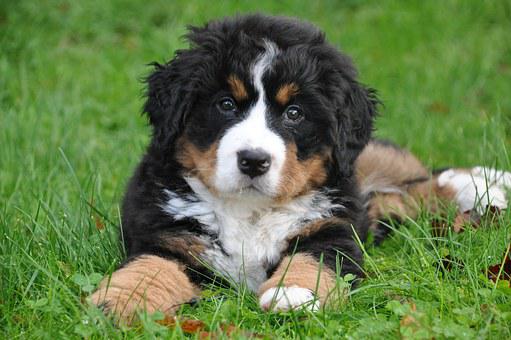The Bernese Mountain Dog cannot handle excessively hot weather or heat that will frequently exceed 75℉ (24 Celcius). The breed prefers cold weather as it was originally bred to live and work in Switzerland’s cold and snowy Alps.

Do Bernese Mountain Dogs Overheat Easily?
Yes, Bernese Mountain dogs do overheat easily. The breed initially emerged as a working dog used in the mountains of Switzerland. This environment rarely gets over 75℉ and is often between 10F and 20F during the long winter months.
The Bernese mountain dog has a thick double coat intended to protect in such a harsh cold environment. The undercoat keeps Bernese Mountain dogs insulated and warm, while the dark topcoat absorbs sunlight.
The coat, combined with its oversized frame, means the Bernese Mountain dog may struggle in the heat. Most Bernese Mountain dogs are between 70-115lbs and around two feet tall. The Berner is one of the heaviest dog breeds in the world. Carrying around more weight makes any dog breed vulnerable to overheating.
The age of your Bernese Mountain dog can also make it more vulnerable to overheating. The Bernese Mountain Dog will live between 6 and 8 years on average. This is one of the shortest lifespans of the species. The older your Bernese Mountain Dog, the more likely they are to suffer the symptoms of overheating.

How To Know if Your Berner is Overheating
According to the American Kennel Club (AKC), all breeds of dogs will show similar symptoms of overheating. You know your dog is overheating when your Berner:
- Pants Excessively
- Has difficulty breathing despite the panting
- Salivates excessively
- Has bright red gums. Other membranes may also be bright red
If the Berner does not get relief, it may start to vomit, lose control of its legs, fall into a coma and eventually die.
If a Bernese Mountain dog is discovered in heat distress, the AKC recommends they always be taken to a veterinarian. Even if they can be cooled and their behavior has returned to normal, it could be that they sustained organ damage and should still be taken to the veterinarian immediately.

What is the Temperature Tolerance of the Bernese Mountain Dog?
The Bernese Mountain Dog can tolerate temperatures from -20℉ to 75-85℉.
Each dog may have their preference, but it is important to remember dogs may not express their discomfort until it is too late.
Hypothermia or heat stroke may set in as your dog looks to be having a good time. Owners must take it upon themselves to monitor their beloved pet’s time outside and the temperature.

What is the Cold Temperature Tolerance of the Bernese Mountain Dog?
The Bernese Mountain Dog can tolerate temperatures down to -20℉.
Therefore, the Bernese Mountain Dog is the ideal dog for a cold-weather climate. With their double coat and large stable paws, these large dogs were bred to live and work in the mountains of Switzerland. The Bernese Mountain Dog is suited for life in a northern climate with a family who loves snowy outdoor adventures.
Despite their natural preparedness for a chilly climate, veterinarians recommend you never leave the Bernese Mountain Dog outside indefinitely. For temperatures between 10℉ and 32℉, the AKC recommendation is between 30 and 60 minutes of outdoor time. If the temperature dips below 10℉, outdoor time should be limited. At these temperatures, Bernese Mountain Dogs are vulnerable to frostbite and hypothermia.

What are the Signs of Frostbite and Hypothermia in Dogs?
Signs of frostbite in dogs include pain in the affected area, cold skin, blisters, stiff movement, and black or dead skin. Veterinarians need to treat frostbite, so if any of these symptoms are identified after cold exposure, it is crucial to take your dog in to be seen.
Hypothermia is a more severe and full-body condition. Some of the initial symptoms of hypothermia are the same as frostbite. A dog in hypothermia will also experience shivering, pale gums, confusion, and confusion. When hypothermia becomes severe, shivering may stop, and the dog may collapse, breathe slowly and become unresponsive. Hypothermia is an emergency and should result in a trip to the veterinarian or emergency animal medical center.
What is the Hot Temperature Tolerance of the Bernese Mountain Dog?
The hot temperature tolerance of the Bernese Mountain Dog ranges from 70-85℉.
The Bernese Mountain Dog was not bred for hot temperatures. Owners should be aware of the dangers of excessive heat for the Bernese Mountain Dog.
When the Bernese Mountain Dog becomes overheated, it is at risk for heatstroke. Heatstroke can kill a dog if it goes untreated. In addition, the dark brown/black coat of the Bernese serves to absorb sunlight rather than reflect it. This results in the breed getting overheated when in the sun more quickly than other dogs.

How can you help the Bernese Mountain Dog Stay Cool?
If you run into weather over the maximum 75℉ preferred by the Bernese Mountain Dog, you can help him stay cool by providing shade, water, and access to an air-conditioned room or the cool basement. If the Bernese Mountain Dog will be outside on a summer’s day, plenty of shade and access to water is vital.
With heavy panting due to overheating, your Bernese Mountain dog can become dehydrated quickly. Dehydration and intense sun can have deadly consequences.
On hot days your Bernese Mountain Dog must be able to stay inside with access to air conditioning or to a cool basement environment. If their home loses electricity during a sweltering day, it is important that the Bernese Mountain Dog is rescued from this situation and moved to a cool environment.
Can the Bernese Mountain Dog live in California?

Yes, Bernese Mountain Dogs can live in California if the California home’s climate is most often below 75℉. There are many parts of California that fit this criterion. The coast and northern California are excellent locations for the Bernese Mountain Dog. Eureka, California, has one of the coolest average summer temperatures of anywhere in the United States. Eureka is an example of one of the places in California that is great for the Bernese Mountain Dog.
On the other hand, the deserts of California, the Mojave, Colorado, and the Great Basin Desert, are all poor choices for the Bernese Mountain Dogs. Additionally, the central valley of California is a less than ideal environment as the average summer temperature is over 80 degrees.
Can the Bernese Mountain Dog live in Florida?

No. It is unlikely the Bernese Mountain Dog will be happy in Florida. Florida has the most humid environment in the United States. High humidity combined with high temperatures makes a dog more likely to suffer overheating or heatstroke. In addition, the Humane Society warns high humidity decreases the effectiveness of panting, and as a result, the dog cannot effectively cool itself.
Florida is closer to the equator than the more northern states in the U.S. Consequently, the sun’s rays are powerful in Florida. The dark coat of the Bernese Mountain Dog will absorb those intense rays, heating it to dangerous temperatures quickly.
At What Temperature Does a Dog Overheat?
A dog’s average body temperature is 101.5℉, overheating and heatstroke can occur at 105℉.
The AKC states a fever in dogs typically does not get over 103℉; if an illness-induced fever gets closer to the 105℉ mark, the dog could be in danger. Symptoms of severe fever in dogs are similar to the signs of heatstroke but may include shivering, coughing, and a runny nose.
Are There Hot Weather Dog Breeds?
Yes, some dogs may thrive in hot weather climates. However, the dogs that thrive in hot weather are smaller dogs like the Chihuahua and Yorkshire Terrier.
In size, dogs closer to the Bernese Mountain Dog include the Great Dane, Labrador Retriever, Golden Retriever, and the Airedale Terrier. Each of these dogs thrives in the heat and loves the water.
Most dogs described as ‘hot weather’ breeds lack the heavy undercoat that insulates the Bernese Mountain Dog. The lack of a heavy undercoat allows a dog to stay cool in the heat.
Despite a dog’s tolerance for the heat, it does not mean they can’t experience overheating or heatstroke. No matter the breed, all dogs can become victims of overheating or heatstroke. Therefore, owners need to be monitoring the temperature, humidity, and time their pet stays in the sun.
Can the Bernese Mountain Dog live in an apartment?
The Bernese Mountain Dog is not a good candidate for apartment living. They are a working breed of dog, so they have a lot of energy. In addition, their large stature makes them especially not suited to small or studio apartments.
The Bernese Mountain Dog will do best with a roomy home and a yard. Even with these amenities, the breed will still need to walk several times a day. An adult Bernese Mountain Dog can easily walk 10 miles a day.
Apartment living could work for the Bernese Mountain Dog if they can get out many times a day and take these long walks they need. However, this would be a significant commitment for an owner. In addition, if the Bernese Mountain Dog cannot get the necessary amount of exercise, they may develop destructive behaviors or excessive barking; either of these outcomes is not ideal for rental spaces with neighbors nearby.
Conclusion
The Bernese Mountain Dog will thrive in cooler climates and be vulnerable to overheating and heatstroke in warmer temperatures. Their double coats and dark fur keep them warm in cold weather but potentially dangerously hot in warm sunny weather.
In addition, the Bernese Mountain dog needs room to spread out and plenty of exercises, ensuring their activity does not lead to overheating or heatstroke.


